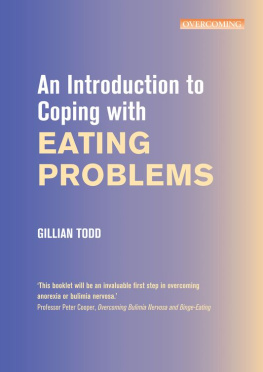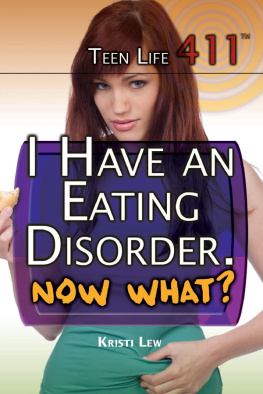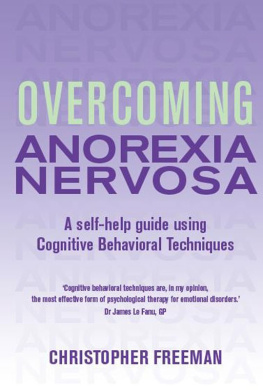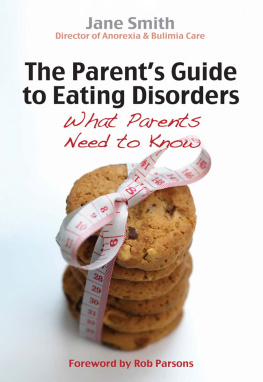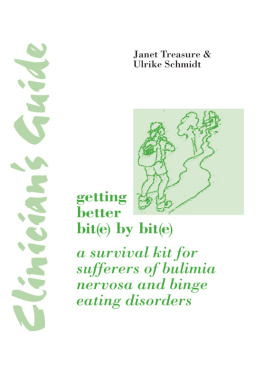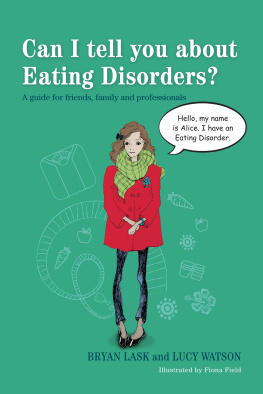Most of us feel unhappy with our appearance at some time or another, especially during our teenage years when our bodies begin to change. Some of us become happier as we get older and become more accepting of ourselves as we develop a wider sense of perspective. Unfortunately though this is not the case with all of us, and sometimes those very normal concerns about our appearance dont improve. We all diet of course but sometimes this may spill over and, instead of us controlling what we eat, the diet (or other things we do to control our weight) begins to control us, and then becomes very important to us. This may happen when a person believes their entire self-worth is based on their weight and body shape. And when the diet becomes so ultra-important it becomes known then as an eating disorder.
This booklet aims to help those of us who have these kinds of problems with eating and it also aims to help our families and friends understand a bit about whats going on. Its an introduction to overcoming issues with food, eating and body image and will help you make a start on your journey to recovery.
Part 1 describes the symptoms of eating disorders . Part 2 looks at practical steps you can take and skills you can use to deal with the issues, including a few written exercises you can complete, with examples to guide you. Weve included a chapter for family and friends that addresses some of the common concerns they might have. Many people find it helpful to read and work through the booklet from start to finish. At least at first, you may also find it useful to make notes as you go along.
When you have problems with eating and dieting you can feel so trapped in patterns of thinking and behaving that it might be difficult to believe youll ever get better. But a majority of people with eating disorders do get better, or at least make great improvements. You can improve, too, by learning how to do something about it. Recovery can be very difficult and take a long time but, if you continue to work on it, the odds will begin to turn in your favour and you will begin to see changes. Keep at it! Every step you take no matter how small is a positive step in the right direction. Setbacks are common and expected but they are something we learn from and make us stronger.
During this recovery process, many of us will need the support of our family and friends. This is a good thing. The right kind of support is a vital part of recovery, and its important for everyone whos involved. No ones expecting immediate changes or an instant turnaround. But, if youve given it a try and make less progress than youd hoped to, or if making changes feels too overwhelming, it may be best to go your family doctor and discuss what alternatives are available. That is also a step on the road to recovery. Your doctor may recommend a qualified therapist or specialist and this may be more helpful for you. Every situation is unique, and it is important that you find the solution that is best for you.
Gillian Todd
Eating disorders are complex and distressing psychological conditions that are common in young women aged between fifteen and thirty. Although the majority of sufferers are female, one in ten people with an eating disorder is male.
People often try to hide their eating disorder because they feel ashamed and guilty about their behaviour. They fear being misunderstood and worry that their friends and family will be dismissive, critical or reject them if they are found out. Often by the time someone seeks help for an eating disorder they will have lived with their problem for many years.
Eating disorders generally fall into three broad categories: anorexia nervosa, bulimia nervosa and something known as Eating Disorder Not Otherwise Specified (EDNOS). People with anorexia nervosa try to avoid food whenever possible but as a result they become so engrossed with thoughts about food and eating that they find it difficult to think about anything else. And whereas most of us tend to think of fruit and vegetables as good and healthy part of our Five a Day and so-called junk food such as crisps or sweets as bad and unhealthy, many people with anorexia have increasingly strict rules about what they will allow themselves to eat. As they limit their food choices, and how many calories they will allow themselves to eat, their list of so-called bad food becomes longer, even if it includes fruit and vegetables.
People with anorexia feel extremely anxious about their weight, and are overly concerned and fearful of becoming fat, and this is why they control and limit food and eating to this extreme. They lose perspective, and feel and sense they are fat no matter how low their weight is or what they see in the mirror. Once anorexia takes hold the drive to be thin takes over any other thought. Unfortunately, even when the person with anorexia becomes extremely underweight, they still feel it is necessary to lose even more weight and this can become dangerous very quickly. It is also very upsetting for family and friends of the person suffering from anorexia, who may often brush aside and dismiss any concerns about their behaviour, even when they begin to feel physically unwell. The desire to lose weight takes top place over anything else.
People with bulimia nervosa also have an overwhelming fear of becoming fat, even though most people with bulimia are a normal weight. Like those people suffering from anorexia, those with bulimia spend a lot of time thinking about their body weight and their body shape, and this then affects their ability to eat normally . People with bulimia tend to alternate between periods of extreme dieting and periods of binge eating, which usually involves eating a very large amount of food quickly and in secret. Crucially, when people with bulimia begin to eat they dont feel they have the ability to stop themselves. Once the binge is over they tend to feel overfull and even more anxious than before and then feel absolutely petrified they will become fat. They try to undo this feeling by getting rid of (or purging) food from their body by making themselves sick or by using laxatives.
The majority of people with eating disorders fall into the category known as EDNOS. What this means is that they arent strictly anorexic or bulimic, but those who suffer from eating disorders in this wider category still require as much care and attention as those who suffer from anorexia nervosa or bulimia nervosa. Some people with EDNOS suffer from a unique eating disorder called binge-eating disorder or BED, which shouldnt be confused with bulimia. Those who suffer from BED binge regularly over a long period, for at least six months and at least twice a week but do not purge themselves. Because they dont make themselves sick, they regularly take in more calories than their body actually needs and tend to become overweight. This in turn leads many people with BED to feel badly about themselves and often misunderstood. As with bulimia, a person with binge-eating disorder feels out of control and powerless to stop eating it isnt just a case of having more willpower. And weve all got to remember that our emotions often affect how we eat. For example, when were stressed or upset, some of us will eat more and some of us will eat less. People with binge-eating disorder eat more, and find that this becomes a form comfort or relief from a problematic situation. It is often a way of avoiding difficult feelings or the circumstances that surround them or cause them in the first place.
The majority of people with eating disorders dont fit neatly in to the category of anorexia, bulimia or binge-eating disorder there is no sharp boundary between the different types because they tend to share some of the same symptoms and features. Its also common for the nature of an eating disorder to change over time.

